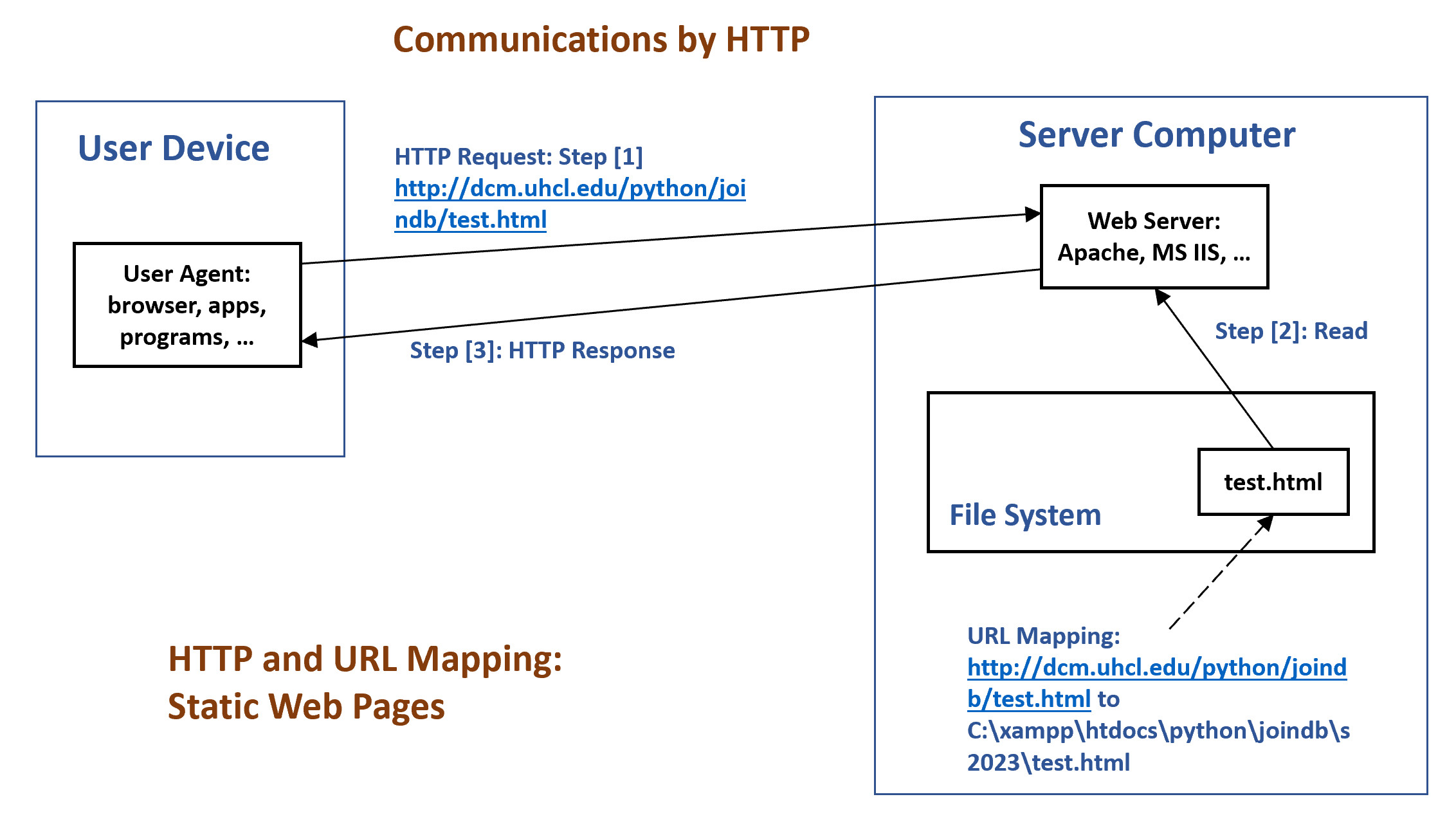
Web Database Development using MySQL/Python/CGI
by K. Yue
1. Python in Web Development
1.1 Set up Python on Apache in XAMPP with barebone CGI
In the httpd.conf (Apache startup configuration file), which is likely in c:\xampp\apache:
This will set Apache to call Python interpreter to handle Web requests with the extension .py.
A major advantage of CGI in a simple course like ours is its simplicity. Well known Python Web platforms such as Django and Flask have many more features and complexity.
However, CGI in Python:
One common problem of Xampp\Apache\Python is that accessing your py page returns a 500+ web server error. One possibility is that Apache does not identify the right Python interpreter to interpret your Python page. In [3] ScriptInterpreterSource Registry, you inform Apache to use windows registry to identify the right Python interpreter and it may not be set correctly.
One solution is to add the she-bang command as the very first line of your Python page, which specifies the location of the Python interpreter. There should be no character before "#!". E.g.: in the first line of your Python Web program.
#!C:\python311\Python.exe
Test it with a Web page such as test.py (from HOWTO Use Python in the web). In test.py below, there are also code added to disable the program to send warnings to the Web server.
#!"c:\python311\python.exe"
import warnings
warnings.filterwarnings('ignore')
# enable debugging
import cgitb
cgitb.enable()
print("Content-Type: text/html;charset=utf-8")
print()
print("<html><body>Hello World!</body></html>")
You may need to set the shebang line to point to your Python interpreter. Your version may be more recent and your path may be different.
1.2 Python-CGI
In the example above,
2. Static Web Pages
2.1 Steps in static Web page development

If localhost is used in the HTTP Request, the server computer is also the user device.
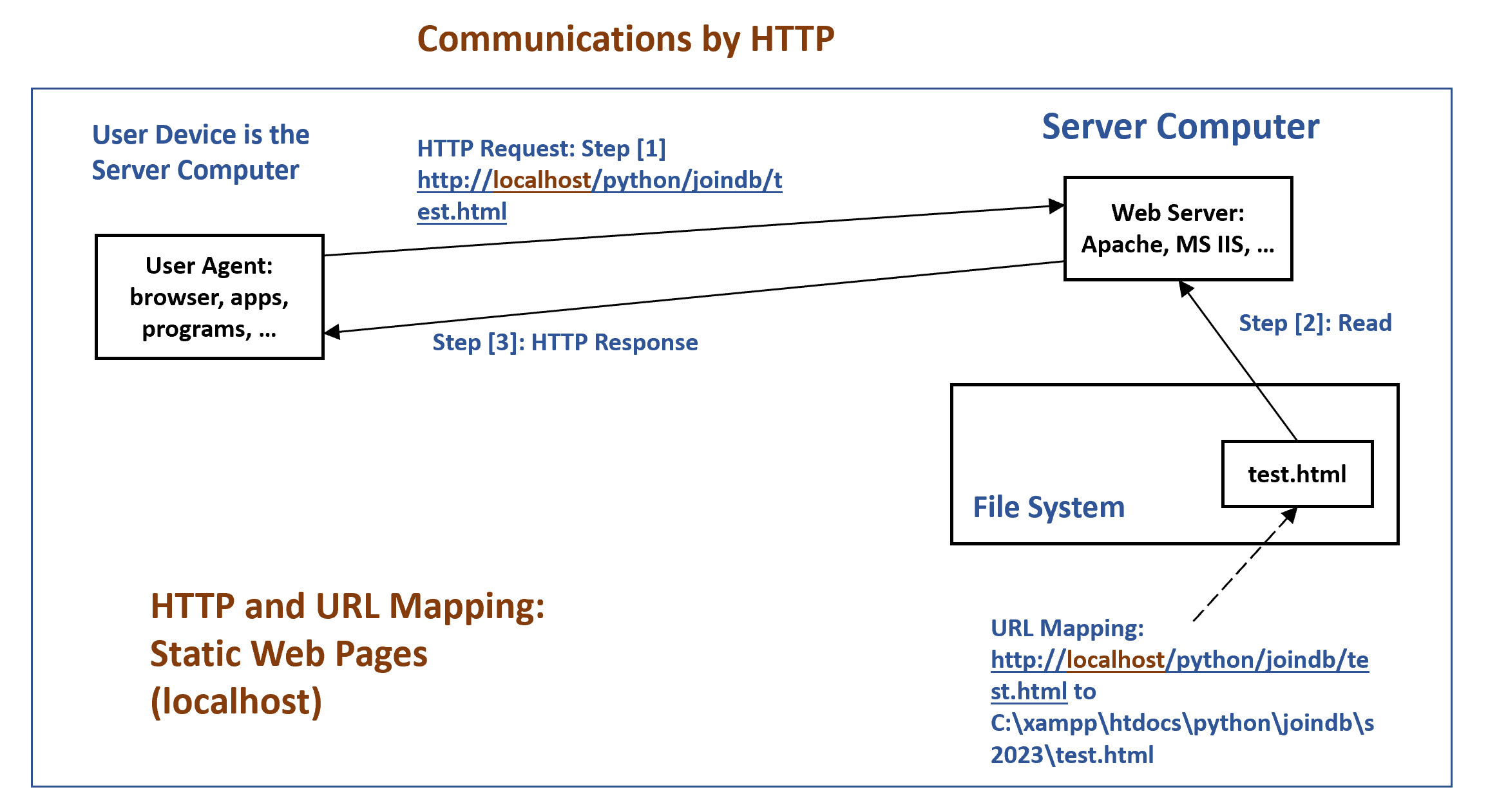
2.2 HTTP
HTTP Request:
HTTP Response
There are many tools that you can use to look at HTTP request and response headers. For example, for Chrome, One may be using the built-in inspector (Control -> Inspect -> Network).
Example:
Using Chrome to access http://dcm.uhcl.edu/yue/:
HTTP Request header may be:
GET /yue/ HTTP/1.1
Host: dcm.uhcl.edu
Accept: text/html,application/xhtml+xml,application/xml;q=0.9,image/webp,*/*;q=0.8
Accept-Encoding: gzip, deflate, sdch
Accept-Language: en-US,en;q=0.8
Cookie: ASPSESSIONIDSQCQRSBD=INENHEEBLFGOGHKFBKIBLAEO; ASPSESSIONIDSQBRRTAC=BHCPCNOBKEBCIGBIAPPGKCCC; ASPSESSIONIDSSCTRSAD=MICBCLJCAEMDBIBIBNBGGIIE; ASPSESSIONIDSSCRSSAC=GKGLGNDDFIMKDKBHLKPDPCHO; ASPSESSIONIDSQBTTRAC=CBABGKODOJHMDCNONKOCPDHN; ASPSESSIONIDSQARTSBC=IGNDLEDDOJEGAGCMBLEICEEI; ASPSESSIONIDQSARTSAD=PKLPPBDBNCHJPBLALOPCJIGN; ASPSESSIONIDSSARRRDD=CMPNGIHAKBPNAOKKGOGLHPFK; ASPSESSIONIDQSARSTAD=PCADGENBBDKFJEMAMDIKEHOB; ASPSESSIONIDQSDTTQBD=JKHNECHCBMCLEHFBGHFMFELC; ASPSESSIONIDSSARRRCC=BAJNJNGAPJOOBMIDAPOIHJHN; ASPSESSIONIDACSSCTQR=CAJBMBBDMCGDNOLIJBGHEEIO; ASPSESSIONIDCARSAQTQ=KFCHGJABODHAJJCJBPNKMICK; ASPSESSIONIDCQRACTCB=POPHJGADHNGFECOGGEOIOFBA; ASPSESSIONIDCQTCARBD=FOBNDOABCKNJBGPMMFFCHFJJ; ASPSESSIONIDASTCARBC=KDHLNLKBDLAPGEIMILDNOFCB; ASPSESSIONIDCQSDCTCB=HPOBPEECPBNPPBIFPMKPHKAL; ASPSESSIONIDCSQTARAS=BDHFPJDCNCAEPFFMFPABAMKM; ASPSESSIONIDQSSSRRTA=CCPDFCHBILLMAFIMLLNBPOAB; ASPSESSIONIDSQSRRQTA=CMDFCOGDGBHDFAHIIADBABJO; ASPSESSIONIDQSSQSQSA=LJOBGGBAEBNGBODOMKDPFLCF; ASPSESSIONIDQSSRQTTB=GFHPPMMAJMDOCAOBKNKHFLPP; ASPSESSIONIDSSQRTRCS=HKOBDDLAABMCJPGNIGFNKMIJ; ASPSESSIONIDSSTTSTBT=DMMLKGKANJPNILMPOAPMHLID; ASPSESSIONIDCARTQCAS=MJMFMKEDNCKKINPHLCIOGNPA; ASPSESSIONIDAATQTDBS=GPGPOCPDJGFLGEGKGHCLJABE; ASPSESSIONIDACRSQCAT=EDPJEGEBEGAHOFNKLLJCLKBJ; ASPSESSIONIDAAAATTBA=OFJJHHJCONLIOFGCCIHACKCG; ASPSESSIONIDAACBSSAA=BEMNHODDCMIHGABJKDONDLBC; ASPSESSIONIDAADASTBB=ECONFFOBCGANIFAOBCPJDIDH; ASPSESSIONIDAADCRSAA=NEIBBLICBGHFINHGPPFCJAKN; ASPSESSIONIDCCDBTRCA=OKFJCGDDMALOAABLJCKMHBBM; ASPSESSIONIDQQRTSRCQ=IKBJHDODEOFFFANBAHFKAAPI; ASPSESSIONIDSSSTQSDR=CGIJNOHCDGBILOOMDOFGLACH; ASPSESSIONIDQQSRTTDQ=IGLDFICDELFIENPMDINFCLJC; ASPSESSIONIDQCDDTTAQ=IPDJJHNDIHKHJLLPOMHGGLCF; ASPSESSIONIDQCDCRQDQ=ONCNOFBBKPGLDEIGIALKHKPO; ASPSESSIONIDQCAAQSDQ=LEHFKPLDJNMEDOCIHBKDMMEH; ASPSESSIONIDQAADRRDQ=LMNNECGAPNGBLONGIMFFOEAB; ASPSESSIONIDACRCRTQD=BPOHFIKBGEBMEEGOBKKBJAGD; ASPSESSIONIDAATDSRRD=LMGJCJPCJLCBJOOIPLFLNCAA; ASPSESSIONIDSQACSRDR=DGNJNLJBLOMAHDEAAOEFCAMM; ASPSESSIONIDQQADQSDQ=PJJFHIOAAGKDJDAFKDIGOMJN; ASPSESSIONIDQSCDQTCQ=JKCHLINCGEHJDFEGHNIBKMIM; ASPSESSIONIDSSBCSSDR=MCGPECIDJNGIEFBMLEHKNOKJ; ASPSESSIONIDSSDCQTDR=COIDIPBAMMBLPGFKCKDEPMNG; ASPSESSIONIDSACSBBTR=DIKJFGMAEDOKGKBFFGANFLNF; __utmc=61056616; ASPSESSIONIDCATSDDST=HIBNGHNDHJLCEKFOFAEDHNPA; ASPSESSIONIDAAQSCDTS=FADLJFICPIFBOGEPFAPEGNIE; ASPSESSIONIDASQRTTAQ=FPHHDCPAGFFKAKCCKEABAJBJ; ASPSESSIONIDAQRTQQDQ=PCPHCJDCOCCGMJOIMDBOKGHG; ASPSESSIONIDASQSTSAQ=KHFDEONCEBMMCACPPGDMNKDB; has_js=1; ASPSESSIONIDQAADDRQA=DPCFGJLALPHKCEFJLCMAIMNJ; ASPSESSIONIDSCCQASAR=CLKFPHBDNCPCDAPGFHOBJEMA; ASPSESSIONIDQAATATBR=NNEHOJMDJCFNKGNFPMDHPJNM; ASPSESSIONIDSQTTCDTA=HKJDFDAABHHHOPGFFDOHDFDO; ASPSESSIONIDSSSQADSC=DDNBIEOBDFJCLODCMNFHINHA; __utma=66415163.264850463.1309620985.1410922342.1428450784.123; __utmc=66415163; __utmz=66415163.1428450784.123.1.utmccn=(direct)|utmcsr=(direct)|utmcmd=(none); .UHCLAuthNet=89A9D736D3B96923E9BCB6E6C53E80E0DDC8DDD4BD0D724749FD14CFF04168C3FBBCDEF2182008646D15199DA8CDF39711261C2BC52AA1EE77D35E00B6FF5C66B3C0BBEE170AC1AB582A889BAA0419EFB36052C406E4372450A65406A8D11844E4828C4802058711568C15831E272DE827ED0C3E; WT_FPC=id=172.29.1.35-3959882976.30274169:lv=1438888300784:ss=1438888300784; _ga=GA1.2.903118926.1438958881
Upgrade-Insecure-Requests: 1
User-Agent: Mozilla/5.0 (Windows NT 6.1; WOW64) AppleWebKit/537.36 (KHTML, like Gecko) Chrome/44.0.2403.155 Safari/537.36
HTTP Response header:
HTTP/1.1 200 OK
Accept-Ranges: bytes
Content-Encoding: gzip
Content-Length: 1970
Content-Type: text/html
Date: Wed, 12 Aug 2015 19:50:09 GMT
ETag: "3be2b1c6662fd01:0"
Last-Modified: Tue, 13 Jan 2015 19:26:06 GMT
Server: Microsoft-IIS/7.5
Vary: Accept-Encoding
X-Powered-By: ASP.NET
For test.html:
If you have curl (https://curl.se/) in your computer, you may use
curl -i localhost/python/joindb/test.html
(replace with your favorite url) to get something like:
curl -i localhost/python/test.html
HTTP/1.1 200 OK
Date: Fri, 23 Dec 2022 22:16:59 GMT
Server: Apache/2.4.43 (Win64) OpenSSL/1.1.1g PHP/7.4.5
Last-Modified: Fri, 23 Dec 2022 22:16:53 GMT
ETag: "2f-5f086249824d1"
Accept-Ranges: bytes
Content-Length: 47
Content-Type: text/html
<html>
<body>
Hello, world.
</body>
3. Dynamic Web Pages
3.1 Dynamic Web page generation using CGI
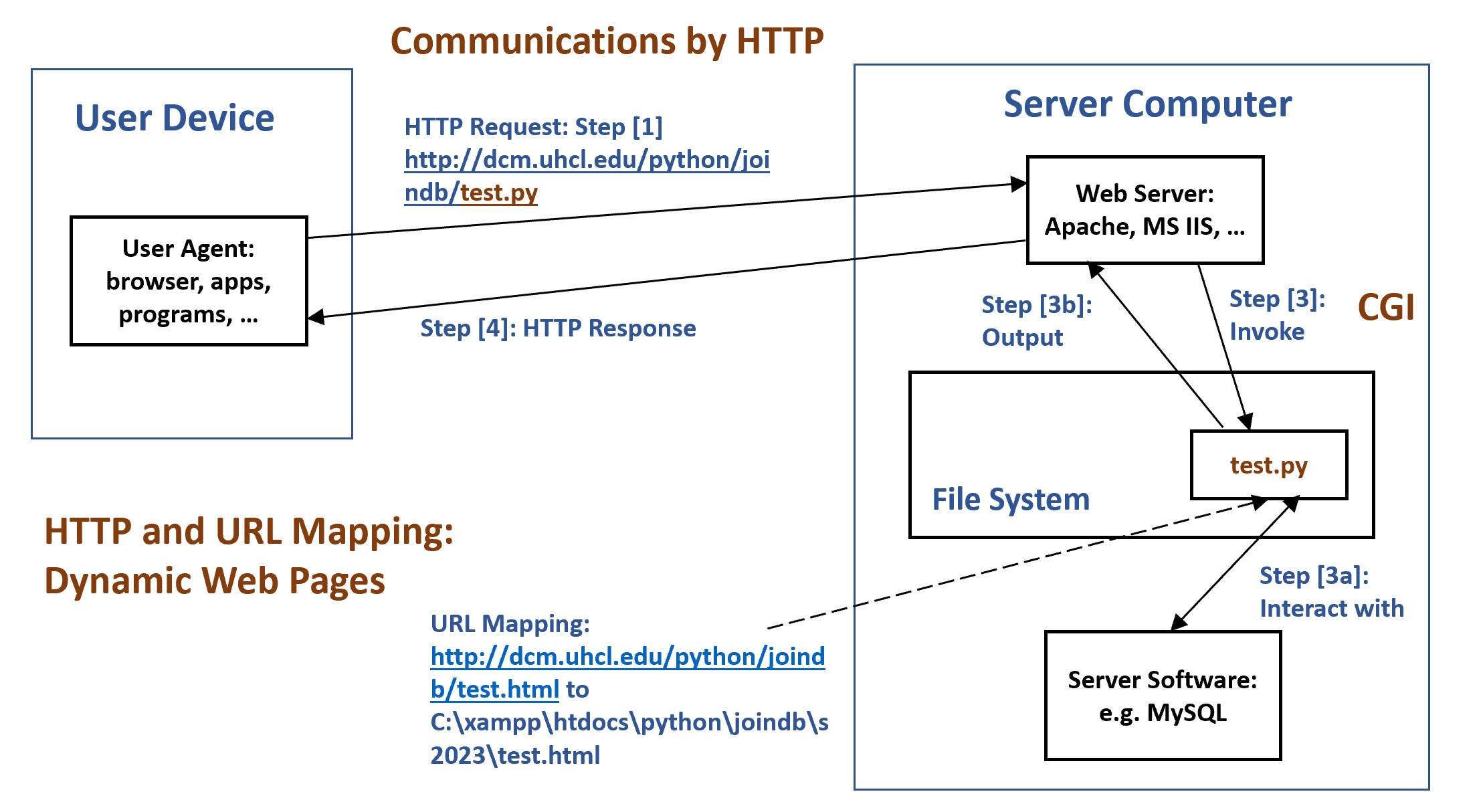
Example:
In the program test.py
#!"c:\python310\python.exe"
# enable debugging
import cgitb
cgitb.enable()
print("Content-Type: text/html;charset=utf-8")
print()
print("<html><body>Hello World!</body></html>")
the Python CGI program output:
The Web Server will 'dress up' the HTTP Response Header.
If you have curl (https://curl.se/) in your computer, you may use
curl -i localhost/python/joindb/s2023/test.py
(replace with your favorite url) to get something like:
curl -i localhost/python/test.html
HTTP/1.1 200 OK
Date: Fri, 23 Dec 2022 22:16:59 GMT
Server: Apache/2.4.43 (Win64) OpenSSL/1.1.1g PHP/7.4.5
Last-Modified: Fri, 23 Dec 2022 22:16:53 GMT
ETag: "2f-5f086249824d1"
Accept-Ranges: bytes
Content-Length: 47
Content-Type: text/html
<html>
<body>
Hello, world.
</body>
3.2 Common Gateway Interface (CGI)
Example
#!"c:\python310\python.exe"
from dbconfig import *
import pymysql
import warnings
warnings.filterwarnings('ignore')
# cgi: Support module for Common Gateway Interface (CGI) scripts.
# cgitb: Traceback manager for CGI scripts
# cgitb.enable(): enable trace back feature
import cgi
import cgitb
cgitb.enable()
# Establish a cursor for MySQL connection.
db = get_mysql_param()
cnx = pymysql.connect(user=db['user'],
password=db['password'],
host=db['host'],
# port needed only if it is not the default number, 3306.
# port = int(db['port']),
database=db['database'])
cursor = cnx.cursor()
# Create HTTP response header
print("Content-Type: text/html;charset=utf-8")
print()
# Create a primitive HTML starter
print ('''<html>
<head></head>
<body>
''')
query = '''
SELECT DISTINCT s.stuId,
CONCAT(s.fname, ' ', s.lname) AS student,
s.ach,
IFNULL(CONCAT(f.fname, ' ', f.lname), 'N/A') AS advisor
FROM toyu.student AS s LEFT JOIN toyu.faculty AS f ON (s.advisor = f.facId)
WHERE s.major = 'CSCI'
'''
cursor.execute(query)
# Read data and generate code for a HTML table.
print('''
<table border='1'>
<tr><th>Student Id</th><th>Name</th><th>Accumulated credits</th><th>advisor</th></tr>
''')
print("<h3>CSCI student info</h3>")
for (stuId, student, credits, advisor) in cursor:
print("<tr><td>{}</td><td>{}</td><td>{}</td><td>{}</td></tr>".format(stuId, student, credits, advisor))
cursor.close()
cnx.close()
print ('''
</table>
</body>
</html>
''')
The Python program sends the following output to the Web server:
Content-Type: text/html;charset=utf-8
<html>
<head></head>
<body>
<table border='1'>
<tr><th>Student Id</th><th>Name</th><th>Accumulated credits</th><th>advisor</th></tr>
<h3>CSCI student info</h3>
<tr><td>100000</td><td>Tony Hawk</td><td>40</td><td>Paul Smith</td></tr>
<tr><td>100001</td><td>Mary Hawk</td><td>35</td><td>Paul Smith</td></tr>
<tr><td>100002</td><td>David Hawk</td><td>66</td><td>Mary Tran</td></tr>
</table>
</body>
</html>
The HTTP response by the Web server:
curl -i http://localhost/.../csciStudent1.py
result:
HTTP/1.1 200 OK
Date: Fri, 23 Dec 2022 23:02:35 GMT
Server: Apache/2.4.43 (Win64) OpenSSL/1.1.1g PHP/7.4.5
Transfer-Encoding: chunked
Content-Type: text/html;charset=utf-8
<html>
<head></head>
<body>
<table border='1'>
<tr><th>Student Id</th><th>Name</th><th>Accumulated credits</th><th>advisor</th></tr>
<h3>CSCI student info</h3>
<tr><td>100000</td><td>Tony Hawk</td><td>40</td><td>Paul Smith</td></tr>
<tr><td>100001</td><td>Mary Hawk</td><td>35</td><td>Paul Smith</td></tr>
<tr><td>100002</td><td>David Hawk</td><td>66</td><td>Mary Tran</td></tr>
</table>
</body>
</html>
Output may look like:
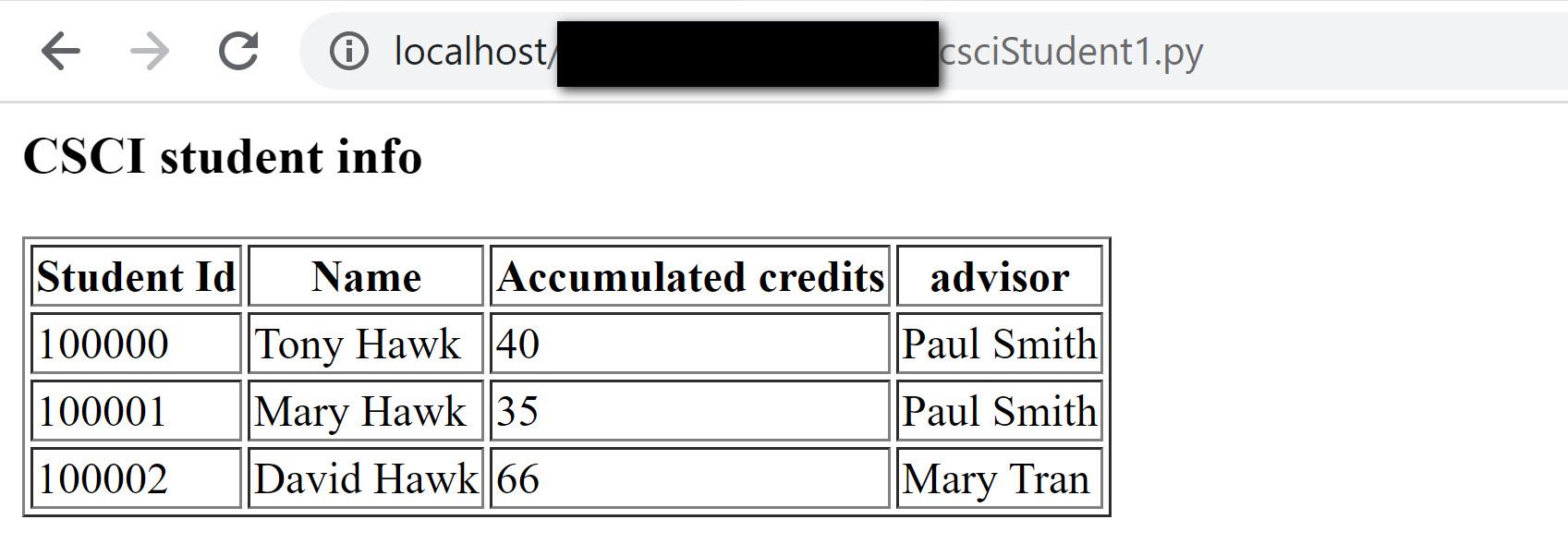
If you want to use dbconfig.py and dbconfig.ini in the dcm server (running IIS), you may need to use the following code that works for Windows IIS.
dbconfig.py:
import configparser
from pathlib import Path
# simplistic and no error handling.
def get_mysql_param(filename='dbconfig.ini', section='mysql'):
config = configparser.ConfigParser()
file_path = (Path(__file__).parent / filename).resolve()
config.read(file_path)
return config[section]
This is needed because the relative filename in Python script in IIS Web server in DCM is not relative to the script directory.
dbconfig.ini for HW assignment hosted in the DSM server:
Method #1:
[mysql]
host = localhost
database = swim
user = <your dcm MySQL user account: e.g., yueb>
password = <your dcm MySQL account password: e.g., Sce1234567!!>
Method #2:
Use the predefined account in DCM: will be discussed in the class.
[mysql]
host = localhost
database = swim
user = dbguest
password = <<to be disclosed in the class>>
Example:
#!"c:\python310\python.exe"
import cgi
import cgitb
cgitb.enable()
print("Content-Type: text/html;charset=utf-8")
print()
print ('''<html>
<head></head>
<body>
''')
form = cgi.FieldStorage()
if "name" not in form or "addr" not in form:
print("<H1>Error</H1>")
print("Please fill in the name and addr fields.")
quit()
print("<p>name:", form["name"].value)
print("<p>addr:", form["addr"].value)
print ('''</body>
</html>
''')
For: http://localhost/.../cgi1.py
or
http://localhost/.../cgi1.py?name=Yue
or
http://localhost/.../cgi1.py?Addr=UHCL

The data sent by the program to the Web server:
Content-Type: text/html;charset=utf-8
<html>
<head></head>
<body>
<H1>Error</H1>
Please fill in the name and addr fields.
For: http://localhost/.../cgi1.py?name=Bun&addr=UHCL:
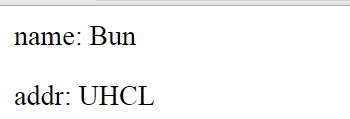
The data sent by the program to the Web server:
Content-Type: text/html;charset=utf-8
<html>
<head></head>
<body>
<p>name: Yue
<p>addr: UHCL
</body>
</html>
The actual HTTP Response sent by the Web Server may be:
HTTP/1.1 200 OK
Connection: Keep-Alive
Content-Type: text/html;charset=utf-8
Date: Thu, 13 Aug 2015 15:45:23 GMT
Keep-Alive: timeout=5, max=100
Server: Apache/2.2.21 (Win32) mod_ssl/2.2.21 OpenSSL/1.0.0e PHP/5.3.8 mod_perl/2.0.4 Perl/v5.10.1
Transfer-Encoding: chunked
<html>
<head></head>
<body>
<p>name: Yue
<p>addr: UHCL
</body>
</html>
4. Basic steps in Web DB development
Example:
Write a Python CGI program, toyu1.py, to accept a HTTP Get parameter major and display the students majoring in major and their number of enrolled courses.
For example, for http://.../toyu1.py?major=CSCI:
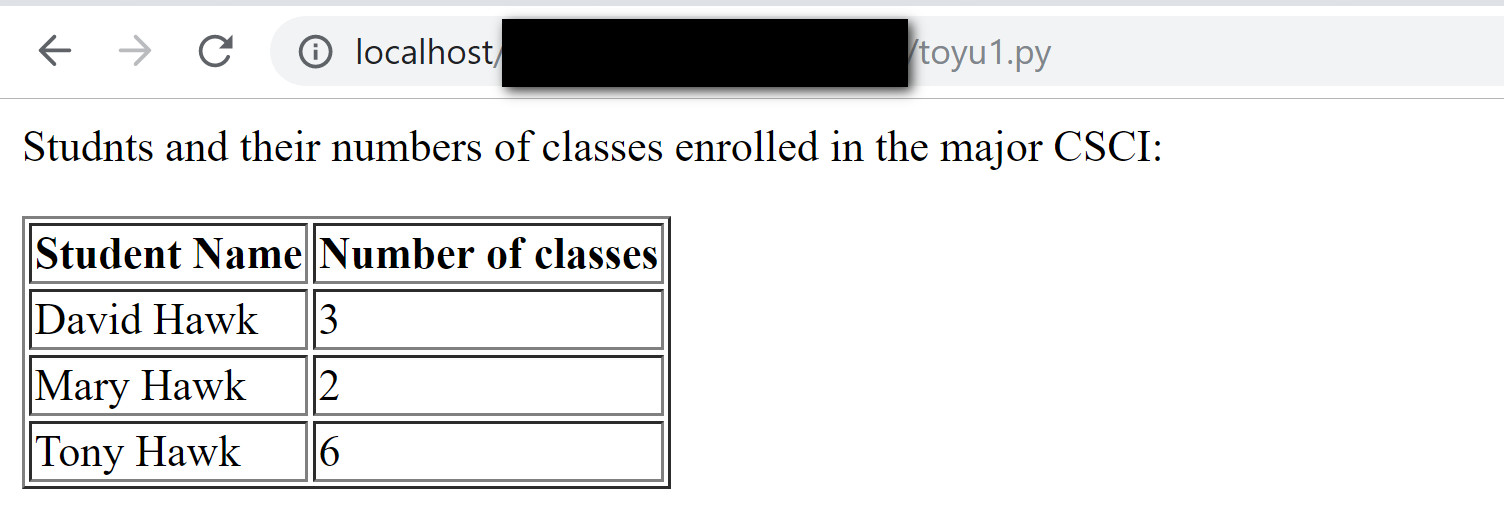

There is no need for error checking of the user input parameter major. A skeleton for toyu1.py is provided for you.
Solution:
[1] Identify the input parameters.
major: typical values: 'CSCI' and 'ITEC'.
[2] Develop the desirable Web page for typical input parameters.
For CSCI:
<html>
<head></head>
<body>
<p>Students and their numbers of classes enrolled in the major CSCI:</p>
<table border='1'>
<tr><th>Student Name</th><th>Number of classes</th></tr>
<tr><td>David Hawk</td><td>3</td></tr>
<tr><td>Mary Hawk</td><td>2</td></tr>
<tr><td>Tony Hawk</td><td>6</td></tr>
</body>
</html>
For ITEC:
<html>
<head></head>
<body>
<p>Students and their numbers of classes enrolled in the major ITEC:</p>
<table border='1'>
<tr><th>Student Name</th><th>Number of classes</th></tr>
<tr><td>Larry Johnson</td><td>2</td></tr>
<tr><td>Catherine Lim</td><td>0</td></tr>
</body>
</html>
[3] Identify dynamic data: Analyze the code of (2) and identify which parts are constants and which parts (dynamic data) should be generated from database.
For CSCI:
<html>
<head></head>
<body>
<p>Students and their numbers of classes enrolled in the major CSCI:</p>
<table border='1'>
<tr><th>Student Name</th><th>Number of classes</th></tr>
<tr><td>David Hawk</td><td>3</td></tr>
<tr><td>Mary Hawk</td><td>2</td></tr>
<tr><td>Tony Hawk</td><td>6</td></tr>
</body>
</html>
For ITEC:
<html>
<head></head>
<body>
<p>Students and their numbers of classes enrolled in the major ITEC:</p>
<table border='1'>
<tr><th>Student Name</th><th>Number of classes</th></tr>
<tr><td>Larry Johnson</td><td>2</td></tr>
<tr><td>Catherine Lim</td><td>0</td></tr>
</body>
</html>
Dynamic Data:
[4] Construct and test the SQL to fetch the dynamic data.
for CSCI:
SELECT CONCAT(s.fName, ' ', s.lName) AS student,
COUNT(e.classId) as num_classes
FROM student AS s LEFT JOIN enroll AS e ON (s.stuId = e.stuId)
WHERE s.major = 'CSCI'
GROUP BY s.stuId, student
ORDER BY s.lName, s.fName;
for ITEC:
SELECT CONCAT(s.fName, ' ', s.lName) AS student,
COUNT(e.classId) as num_classes
FROM student AS s LEFT JOIN enroll AS e ON (s.stuId = e.stuId)
WHERE s.major = 'ITEC'
GROUP BY s.stuId, student
ORDER BY s.lName, s.fName;
The typical input will be replaced by a parameter in the Python/SQL code.
[5] Write the Python code for (3) accordingly.
#!"c:\python310\python.exe"
from dbconfig import *
import pymysql
import cgi
import cgitb
cgitb.enable()
print("Content-Type: text/html;charset=utf-8")
print()
print ('''<html>
<head></head>
<body>
''')
#
db = get_mysql_param()
cnx = pymysql.connect(user=db['user'],
password=db['password'],
host=db['host'],
# port needed only if it is not the default number, 3306.
# port = int(db['port']),
database=db['database'])
cursor = cnx.cursor()
form = cgi.FieldStorage()
major = form.getfirst('major')
if major is None:
print ('Please enter a valid major code in the URL.')
print ('</body></html>')
quit()
query = '''
SELECT CONCAT(s.fName, ' ', s.lName) AS student,
COUNT(e.classId) as num_classes
FROM toyu.student AS s LEFT JOIN toyu.enroll AS e ON (s.stuId = e.stuId)
WHERE s.major = %s
GROUP BY s.stuId, student
ORDER BY s.lName, s.fName;
'''
cursor.execute(query,(major,))
row = cursor.fetchone()
if row is None:
print ('Sorry, no major with code {}. Please enter a valid major code in the URL.'.format(major))
print ('</body></html>')
quit()
print('''<p>Studnts and their numbers of classes enrolled in the major {}:</p>
<table border='1'>
<tr><th>Student Name</th><th>Number of classes</th></tr>
'''.format(major))
while row is not None:
(student, count) = row
print("<tr><td>{}</td><td>{}</td></tr>".format(student, count))
row = cursor.fetchone()
cursor.close()
cnx.close()
print ('''</body>
</html>''')
Some hints for debugging